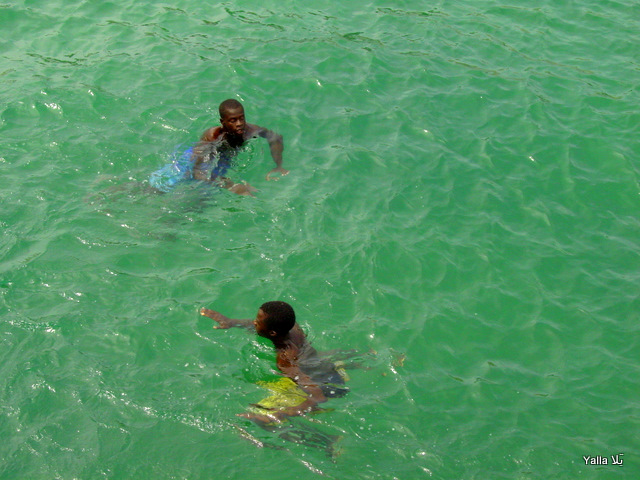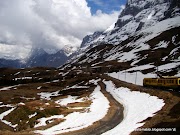Not discouraged by the challenges of the first few hours and the incident at the Malian market, we went on to explore Sandaga, the biggest and most chaotic market in Dakar. It's a real visual feast with all the colorful fabrics, the beautiful handicrafts, and the plethora of spices. African tunes are played on stereos and the noise of constant chatter in Wolof (the local vernacular) fills the air. Our local guide was a real asset there, without him we could easily have gotten lost in the maze of stalls. Careful about always asking for permission before taking a photo, this time we did not stir any emotion.
Az első pár óra nehézségei azért nem tántorítottak el bennünket, úgyhogy folytattuk Dakar felfedezését. Sőt, még a piaci incidens sem bizonyult elégnek, mert következő állomásunk ismét egy piac volt, mégpedig a város legnagyobbika, a Sandaga. Itt a káosz egészen új szintjeivel találkoztunk, a standok labirintusa rengeteg színes ruhát, illatos fűszert, nem annyira illatos halakat és még ezernyi mást rejtett. A hangszórókból zengő afrikai dallamok és az árusok hangos beszélgetéseinek elegye töltötte meg a teret. Itt persze udvariasan engedélyt kértünk minden fénykép előtt, úgyhogy kevésbé zaklattuk fel a helyieket.
We did however feel the urge to escape all the bustle, so we headed to the ferry terminal and took the first boat to Gorée, the quaintest, most laid-back and most beautiful spot in Dakar. Just a few miles offshore, Gorée Island is a World Heritage site since 1978 and one of the oldest European settlements in Africa. It is actually a picturesque little village, overlooked by a fort at the northern tip of the island. As we roamed the narrow car-free streets, we were surrounded by bougainvilleas, colonial houses with wrought-iron balconies and palm trees swaying in the breeze. Children were playing in the shallow waters of the tiny beach, adults were chatting or napping under the shade of palms. A haven of peace indeed.
Sandaga nyüzsgő volt és hangos, úgyhogy innen különös élmény volt kompra szállni, majd rövidesen Dakar legnyugodtabb, legszebb és legcsöndesebb helyére érkezni: Gorée szigetére. Bár az 1978 óta a Világörökség részét képező sziget mindössze pár mérföldre van a belvárostól, hirtelen egy festői faluban találtuk magunkat, autómentes utcákon, kovácsoltvas erkélyekkel szegélyezett gyarmati házak között. A pálmafák ágait finoman fújta a szél, gyerekek játszadoztak az apró strand sekély vízében, az idősebbek beszélgettek vagy szunyókáltak az árnyékban.
It was hard to imagine that this idyllic little island was once a busy center of trade and also had the dubious honor of being a slave shipment point. The House of Slaves (Maison des Esclaves) is the only reminder of the grim past, featuring dark dungeons where people would languish for months before being shipped to America.
Nehéz volt elképzelni, hogy ez az apró, idilli sziget egykoron az afrikai rabszolga-kereskedelem egyik legjelentősebb központja volt. Ma már mindössze a Rabszolgák Háza (Maison des Esclaves) emlékeztet a sötét múltra, amikor az épület celláiban emberek ezrei sinylődtek hónapokig, mielőtt Amerikába szállították őket.
Having been refreshed in this beautiful oasis of tranquility, we headed back to Dakar proper, only to battle traffic and engage in a few more conversations without ending up with less money than before. The hustler-record of the day was set at the modern main square, Place de l'Independence, where no less than six people approached us in about twenty minutes. We were never alone for more than a few seconds. When we finally returned to the hotel and washed down the day with a bottle of excellent local Gazelle beer, not even the crickets could keep us awake.
Gorée számunkra olyan volt, mint egy oázis a sivatagban. Felfrissülve és lelkesen érkeztünk vissza Dakar belvárosába, ahol aztán a függetlenségről elnevezett főtéren (Place de l'Independence) megdőlt a minket zaklató árusok rekordja: nagyjából húsz perc leforgása alatt hatan próbálkoztak legombolni némi pénzt rólunk. Miután visszaértünk a szállásra és lemostuk a napot egy üveg igen finom szenegáli Gazelle sörrel, még a korábban már említett tücskök sem tudtak ébren tartani bennünket.
 |
| A visitor we didn't like... / Őt nem "lájkoltuk"... |
Dakar later turned out to be the perfect example of why first impressions often don't last. On our first day, after the initial shock of wandering unfriendly streets, it was only tranquil Gorée that shone as our beacon of hope that we could actually grow to like this city. However, a walk on another day revealed faces of Dakar I had never thought existed. Just a few blocks from some dreary high-rises there was a Dakar of Viennese-style coffeehouses, beauty parlors, tree-lined streets with fountains, some of the fanciest-looking street signs I've ever seen, a great French Cultural Institute that runs remarkable exhibitions. There was a bar where Europe and Africa mingles, an immensely elegant presidential palace and a huge cathedral in this predominantly Muslim country.
Végül Dakar tökéletes példájának bizonyult, hogy miért csalóka az első benyomás. Míg első nap a barátságtalan utcákon való barangolás után egyedül Gorée szigetét találtuk vonzónak, újabb séták során kiderült, hogy Dakarnak olyan oldalai is vannak, amelyek még a képzeletünkben sem léteztek. Találtunk bécsi kávéházat, szépségszalonokat, fákkal és szökőkutakkal szegélyezett sugárutakat, elegáns kormányépületeket és egy hatalmas székesegyházat az egyébként túlnyomóan muzulmán városban. Élveztük a francia kulturális központ kiállításait, majd jót söröztünk az árnyas bárban, ahová afrikaiak és európaiak mind szívesen járnak.
 |
| The Presidential Palace in Dakar / Dakar: Elnöki palota |
In retrospect, it is strange why we needed things reminiscent of home to feel good in Africa. But we did, and now I see how this multi-sidedness of Dakar makes it a great city. It is quintessentially African the way it is. There are the remnants of a grand colonial history in many fine buildings and a sophisticated European neighborhood. There are the challenges of contemporary Africa in the visible poverty of shabby streets, crumbling infrastructure and all the hustlers. And there is the hope of the future in a bustling nightlife with trendy bars and restaurants, new office buildings and a general sense of normalcy without soldiers and roadblocks at every corner. All in all, Dakar is a really interesting city but is not a cheap date. You need to dig deeper to appreciate its charms, but then again, it makes you feel like you've earned it.
Utólag fura belegondolni, hogy miért volt szükségünk európaias helyekre ahhoz, hogy jól érezzük magunkat Afrikában. Mostanra már világos, hogy nem a jobb városnegyedek teszik Dakart élvezhetővé, hanem a sokszínűség. Dakar igazi afrikai metropolisz. A kifinomult európai negyedben benne él a gyarmati múlt. A látható szegénység mutatja a jelen kihívásait. Az élénk éjszakai élet, az új éttermek és irodaházak, valamint az általános nyugalom (csak az árusok piszkálnak: nincsenek katonák és ellenőrzőpontok minden sarkon) pedig egy jobb jövő reményével kecsegtet. Összességében Dakar különleges város, de nem adja könnyen magát.











